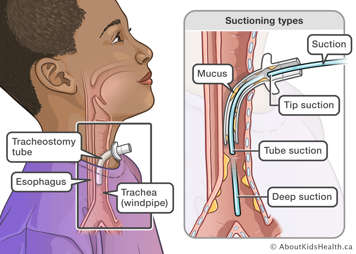At the end of this chapter, you will be able to:
- describe different types of secretions
- identify when suctioning is needed
- discuss equipment needed to suction
What are secretions?
Secretions (mucus) are normally produced in the nose, mouth and trachea. Secretions are usually clear or white and are either coughed up or suctioned out of the lungs.
A change in the colour, amount, consistency or smell of secretions may be the first sign that your child is getting sick or that something else is wrong.
The following are different types of secretions that your child may have and their common causes.
| Secretion characteristics | Potential causes |
|---|---|
|
|
|
|
|
|
|
|
|
|
Important: If you notice a change in the colour, amount, smell or consistency of your child's secretions, contact your health-care team immediately.
What is suctioning?
Suctioning involves removing excess secretions from the nasal cavity (area behind the nose), mouth, throat, trachea and tracheostomy tube. It is usually done with a device called a suction machine. Some of these areas are suctioned directly and other areas are suctioned through the tracheostomy tube.
Why do I need to suction my child's airway?
You need to suction your child's airway because your child needs help to clear secretions so they can breathe more easily. When your child has a tracheostomy tube, it is important to suction it regularly so that it does not become blocked.
When do I need to suction my child?
Most children need to be suctioned at least three or four times a day. Your child needs to be suctioned when:
- their cough is more frequent or sounds more congested than usual
- they are having trouble breathing or their breath sounds are harsh
- you can see secretions in the tracheostomy tube or ventilator tubing
- you can hear a gurgling noise while your child is breathing
- the ventilator airway pressures are higher than normal
- their oxygen saturations are lower than normal
- the child has vomited, and you need to suction out the mouth and/or throat via tracheostomy
- you suspect aspiration (your child has inhaled food or liquid)
- before eating to assess the patency of the tube (make sure the tube is clear and open)
- before certain therapies (e.g., cough assist therapy)
- before providing inhalation medication (e.g., Ventolin puffer)
What are the different types of suctioning?
There are eight ways to suction your child's airway:
- nasal suction (suctioning the area behind the nose)
- oral suction (suctioning the mouth)
- nasopharyngeal suction (suctioning deeper into the back of the nose)
- oropharyngeal suction (suctioning deeper into the back of the mouth and throat)
- tracheostomy tip suctioning
- tracheostomy tube suctioning
- tracheostomy deep suctioning
- inline suctioning (when a child is on a ventilator)
Choosing where to suction will depend on the location of the secretions you want to remove.

Nasal suctioning
With nasal suctioning, a suctioning tip device or a catheter is used.
Oral suctioning
For oral suctioning, you can use a tip suction device for infants, or a larger, plastic suction device called a Yankauer to suction secretions in the mouth. The tip suction device or Yankauer may have a hole that you cover with your thumb to start suctioning along with smaller holes along the end, through which the mucus passes.
It is useful when your child is:
- unable to remove secretions by coughing (for example, they have a weak cough)
- drooling because they cannot swallow
- vomiting
Oropharyngeal suctioning
Oropharyngeal or OP suctioning involves passing a catheter into the back of the mouth. This is done to clear secretions (mucus) from the back of the throat if a child is unable to cough them up into their mouth or swallow them.
Nasopharyngeal suctioning
Nasopharyngeal or NP suctioning involves passing a catheter into the nose and further into the nasal passage. This is done to clear secretions (mucus) from the back of the throat if a child is unable to cough them up into their mouth or swallow them.

Tracheostomy tip suctioning
Tip suctioning involves using a suctioning tip device or a catheter to remove mucus from just the opening of the tracheostomy tube that the child may have coughed up.
Tracheostomy tube suctioning
Tube suctioning involves removing mucus from the full length of the tracheostomy tube, including just past the far end of the tube. This is a pre-measured length. Your child’s health-care team will teach and inform you of this distance.
Tracheostomy deep suctioning
Deep suctioning allows you to remove mucus from your child’s airway between the end of the tracheostomy tube and the carina (the part where the trachea splits into the bronchi, the tubes that go into the lungs). Deep suctioning is usually recommended in urgent situations.
If at any time, blood, food and/or formula are suctioned from the tracheostomy, notify your healthcare team right away. This is not a normal occurrence. If possible, try and avoid suctioning immediately after feeding to minimize the risk of vomiting and/or aspiration.
Inline suctioning
Children who have a ventilator attached to their tracheostomy tube have another way they can be suctioned. This is called inline suctioning. More about inline suctioning can be found in the ventilation manual.